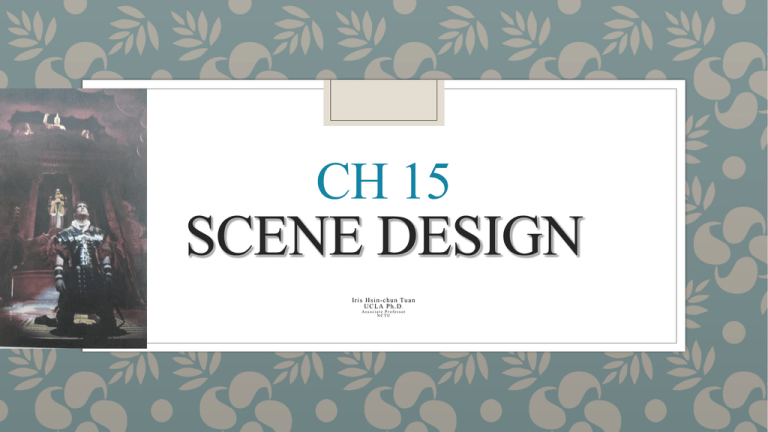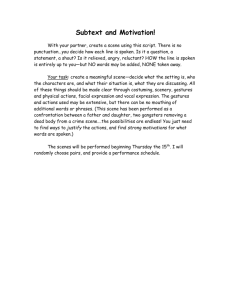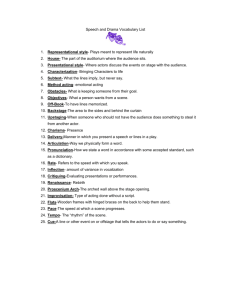PowerPoint **
advertisement

CH 15 SCENE DESIGN Iri s Hs i n -chun Tu a n UC LA Ph . D . Associate Pr ofessor NCTU The Function of Scene Design ◦ Scene design defines the performance spaced by establishing distinction between onstage and offstage. ◦ Scene design creates a floor plane that provides opportunities for movement, composition, character interaction, and stage business. ◦ Scene design visually characterize the acting space. ◦ Just how it does so depends on the production concept. The Scene Designer’s Skills ◦ In creating appropriate interiors, designers also need some of the actor’ skills because they must understand the characters who inhabit the spaces and whose tastes have dictated the choice of furnishings and decorative features. ◦ Scene designers need to be grounded in art history (including architecture, crafts, and decorative arts ), because in creating settings, designers must be familiar with architectural styles and the history of decorative motifs, furniture, and accessories. ◦ They may wish to create a setting done in the surrealistic style of Salvador Dali or one that uses a particular artist’s color palette. The Scene Designer’s Skills ◦ Designers should be familiar with ◦ New materials ◦ Technologies ◦ their potentials for design purposes ◦ Plastics, Styrofoam, and laser projections have opened up new possibilities and stimulated innovative designs. ◦ Three-dimensional animation programs ◦ can help designer communicate to others how the multiple sets, or parts of them, may move. Working Plans and Procedures ◦ Using computer-assisted design programs ◦ Design decisions ◦ How the settings function as acting spaces ◦ How they relate to costume and lighting designs and the total ”look” of the production. ◦ Designs are rendered as perspective color sketches Ming Cho Lee ◦ Ming Cho Lee ◦ The most influential of contemporary American scene designers. ◦ Born in China ◦ Learned landscape watercolor there before coming the United States in 1949. ◦ Scaffolding ◦ Suggesting collage ◦ Although by 1980 Lee’s designs had become more realistic, he is still usually associated with a spare, elegant, minimalist style. ◦ Yale University’s School of Drama. ◦ Ming Cho Lee ◦ Whereas on Broadway stars, directors, or producers exert too much control. ◦ Lee considers his strengths as a designer to be his sense of proportion and his understanding of the demands and restrictions of various kinds theatrical space- arena, thrust, or proscenium. ◦ Basic Scenic Elements ◦ They tend to be fragmentary and evocative rather than completely representational, many being wholly abstract. ◦ Traditional stagecraft practices still play a major role ◦ Soft-Scenery Units ◦ Among the most common soft-scenery units are drops, draperies, scrim, and cycloramas. ◦ Drops are used to enclose setting at the back and to provide surface on which scenes can be painted. ◦ A drop may also have portions cut out so that another drop or object is visible behind it, thereby creating apparent depth and distance. ◦ Draperies may be hung parallel to the proscenium on either side of the stage in the manner of wings. ◦ Scrim, a specialized curtain made of gauze, appears opaque when lighted only from the front but is transparent when lighted from behind. Soft-Scenery Units ◦ It may be used initially as background for a scene and then become transparent to show another scene behind the first one; ◦ It may be used for the appearance and disappearance of ghosts and apparitions; ◦ It can create the effect of seeing a scene through fog, mist, or the haze of memory. ◦ A cyclorama ◦ Any arrangement of curtains that surrounds the stage area on three sides. ◦ It may be composed of draperies, but typically(to avoid the appearance of seams) it is a continuous, tightly stretched curtain suspended on a U-shaped pipe curving around the back and side of the stage. ◦ Soft – scenery units ◦ are used more extensively on proscenium stages than on thrust or arena stages, where less masking is needed and where scenic units more easily interfere with sightlines. Framed Units ◦ The basic framed units is the flat. ◦ A flat is a wooden or metal frame covered by a relatively flat surface(either stretched cloth or a thin sheet of wood ) that can be painted or treated texturally. ◦ Three types are typical: ◦ Flats without an opening (for wall, etc.) ◦ Flats with an opening ( for doorways, windows ,etc.) ◦ Flats specifically cut or pieced together to simulate a particular silhouette(such as trees, distant vistas, etc.) Framed Units ◦ Screens have become typical framed units since the 1960s, when the incorporation of projected still or moving pictures became common. ◦ Screens may be used alone or with other screens. ◦ They may rest on the floor or, more commonly, be suspended above the stage. ◦ They may be of any shape or size and made from almost any material-wide-mesh netting, translucent plastic, textured cloth, and so on. ◦ Three-Dimensional Units ◦ Certain other scenic pieces, though they may not always be weight –bearing, are still usually built as three-dimensional forms. ◦ These include ◦ Rocks ◦ Tree trunks ◦ Columns Innovative Materials and methods ◦ A variety of substitutes for wood may be used Steel, aluminum, and other metal alloys offer greater strength and support than the same amount of wood, but weight more and have less flexibility. ◦ Fiberglass ◦ May be molded into rocks and other shapes and allowed to harden, creating lightweight pieces capable of supporting heavy loads. Assembling and painting Scenery ◦ Be achieved by spattering ◦ Flicking small drops of paint from a brush onto the vase coat ◦ Rough plaster may be simulated by rolling, which involves a rolled-up piece of rough-textured cloth dipped in paint and rolled over the base coat in irregular patterns. ◦ Other common painting techniques ◦ Sponging ◦ Scumbling ◦ Lining Shifting Scenery on Stage ◦ The least sophisticated method involves manual scene shifting. ◦ Flying ◦ Suspending scenic elements above the stage and raising or lowering them as needed. ◦ Another common device for shifting scenery is the wagon (a platform on casters) ◦ Still another shifting device, the elevator stage, raises and lowers segments of the stage. ◦ In some theatres, portions of the stage may be lowered to a basement, where scenery is mounted and then raised to a basement, where scenery is mounted and then raised to stage level. ◦ Efficiency and rapidity are the primary concerns. Set Decoration and Properties ◦ Set decoration and properties ◦ Items as banners ◦ Coats-of-arms ◦ Window draperies ◦ Furniture ◦ Pictures ◦ Books Any thing that completes the setting.






